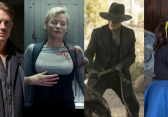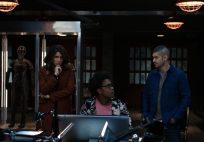Flashbacks added dimension and human drama to this supernatural tale.
Tropes were turned on their head in shocking and progressive ways.
Tragic deaths raised the stakes and added an extra layer of suspense.
The cinematography, editing, 80s setting, and music created an unsettling and creepy tone.
Strong performances heightened a likable cast of characters.
An over-reliance on horror cliches diminished the show's fear factor.
The flashback formula left audiences waiting too long for numerous side characters to get developed.
Cheesy moments and logic gaps were plentiful.

Horror, Human Drama, and an Excellent Ensemble Cast Made ‘Dead of Summer’ A Highly Entertaining, If Somewhat Campy, Summer Program
Dead of Summer is a very hard show for me to review. Season one had a bumpy start but the back half addressed nearly all of my worries and criticisms. Dislikable characters were fleshed out, the body count rose, and disappointing flashbacks were turned on their head. By-the-numbers romance plot lines either died out or turned into something progressive and real. All of this appears to be by design. Tropes were set up to be turned on their head. Basically, I feel duped in the best way possible. That leaves me in an odd place looking back on the season as a whole. I stand by my feelings that the first four or so episodes felt bloated. One note characters, heavy exposition, and predictable romance scenarios were abound. Does the fact that the writers appear to have been aware of this make those episodes “good”? I’m certainly more impressed with them in hindsight, but should each episode of a serialized show have to stand on its own? The answer to that feels quite subjective, but one thing’s for sure, I enjoyed season one’s ride.
RELATED | Dead of Summer 1.01 Review – “Patience”
This is a tight ten episode season where every moment counted. Though it didn’t always feel that way, it’s clear that creators Adam Horowitz, Edward Kitsis, and Ian B. Goldberg put a great deal of care into mapping out their story. Seeds were planted early on, foreshadowing was everywhere, and the show’s mythology was disclosed to the audience in a slow but steady manner. It feels like an extended horror film that I can confidently recommend to a friend even if it doesn’t get picked up for another season. Oh, and I can also tell them that it has one of the funnest twists in horror television.

Twisting Tropes
Slasher films are known for their blatant use of tropes and archetypes. They’ve had a formula for decades. Teens are murdered one by one for such horrific sins as drinking and having sex. The usual cast of characters include a jock, a nerd, a stoner, and a promiscuous vixen. Most importantly, there’s the virginal female protagonist (AKA final girl) who defeats the killer against all odds but is left broken and alone. In a post ‘Scream (1996)’ world slashers often comment on these tropes in an attempt to subvert them. Dead of Summer is the next step in meta commentary. It set up the familiar archetypes only to turn them on their head without needing to point out what it was doing. The promiscuous mean girl, Jessie, is actually our selfless final girl. The straitlaced hero, Garrett, has quite the dark side and creepy loner Drew just doesn’t want people to know he’s a transgender man. The greatest twist of all however, was discovering that Amy, our vanilla final girl, was actually our psychopathic killer all along.
RELATED | Dead of Summer 1.02 Review – “Barney Rubble Eyes”
Amy was a sore spot for me early on. She felt incredibly generic and in a world of Grace Gardners (Scream Queens) and Emma Duvals (MTV’s Scream) I felt poised to be getting yet another boring horror protagonist. Elizabeth Lail’s performance, while never bad, fell flat for me and Amy’s backstory was by far the weakest. When it became clear that she was the “chosen one” that our friendly neighborhood demon wanted to possess, I became more interested. Sure, it was kind of annoying that it seemed like Malphas wanted her because she was “pure” but at least I’d get to see Elizabeth Lail be all evil and demonic. I was blown away by the twist that Amy had been welcoming the demon from the start, that her flashbacks were inaccurate, and that she’d been killing the counselors all along. It wasn’t just a split personality or demonic possession, Amy had been putting on a show for us since episode one. Lail killed it as psycho Amy and the flashbacks in “Home Sweet Home” played with our expectations perfectly.

The Flashback Formula
Some might say using flashbacks is a storytelling crutch. Coming from ‘LOST’ and ‘Once Upon a Time‘ the character-centric flashback thing has certainly become a formula for these creators. Thing is, I can’t really blame them. The flashbacks might actually be the best part of this entire series. They ground a cartoony supernatural tale in something real and human. One by one the characters were given depth and likability. On the positive side this meant the show could tackle some interesting social issues while also shifting focus away from fake Amy. The unfortunate negative consequence? I wasn’t fully on board with some of the characters until episode eight or nine. This feels like a flaw in the formula. Joel, Garrett, Amy, and, to a lesser extent, Jessie all felt two dimensional until their twists were revealed. Their scenes and characterization felt bland and irksome until they were injected with 50ccs of flashback. Perhaps the pilot’s title was a hint that this series would require a great deal of “patience,” but I’m not so sure that one should have to slog through half a season for a character to become interesting. It’s one of the difficulties with having such a large cast but I can’t help feeling like other shows have handled this better. At the end of the day however, the flashbacks rocked.
RELATED | Dead of Summer 1.03 Review – “Mix Tape”
Drew’s flashbacks stood out as some of the best. Showing the trials and tribulations of a transgender man feels almost unheard of in a genre context. This show went where others wouldn’t and it’s to be commended for its progressive storytelling and diverse cast. Cricket’s backstory told a relatable tale of body shame while Joel’s commented on the potential horrors of mental illness. This show discussed poverty, bad parentage, and prejudice. What’s more? It did so with some of the best child actors I’ve ever seen. Speaking of which, shout-out to the episode “Townie” for showing an adorable and believable love story between two young teens. The only flashbacks that stood out to me as poorly handled were Deb’s. Sure, the twist was fun, but Deb honestly felt less interesting to me after her flashbacks than before. She’d been given too much mystery and intrigue and so her love story kind of fell flat.

Demons, Psychos, and Satanists, Oh My!
To be honest, supernatural horror isn’t usually my thing. I find real world horror far more frightening and I feel like the rules of ghostly monsters are often ill defined to fit whatever the plot needs at that moment. Grounding the final conflict in a version of Amy therefore worked very well for me. Despite the heightened nature of the finale it was still rooted in character drama more than just the ethereal idea of a demon or ghost. Overall though, I found Dead of Summer’s horror elements to be a mixed bag.
Strong cinematography and fantastically eerie music worked their hardest to strike up an unsettling tone in a series which sometimes felt held back by the constraints of its network and intended audience. Large portions of the violence were more implied than shown which took some bite out of what was occurring. Cheesy moments were plentiful with magic lightning strikes, balloon attacks, and inconsistent CGI. The show often fell into cliché territory with the horror as well. We got all the essentials: girls speaking with low demon voices, a ouija board sequence, creepy children, and exorcisms.
RELATED | Dead of Summer 1.04 Review – “Modern Love”
That’s not to say the horror was all bad. The pilot had some great moments like the hands reaching for Amy and the claustrophobic closet scene. Additionally, the satanists collective suicide was shocking and their masks were suitably creepy. “How to Stay Alive in the Woods” really delivered on the fear as Eli Goree expertly portrayed Joel’s unraveling psyche. We could feel his urgency and panic. Tony Todd also brought the scares early on as the intimidating spirit, Holyoke. His presence, while ultimately benevolent, was quite unnerving.
Adding to the general sense of suspense was the show’s willingness to kill off beloved characters. After Cricket’s shocking death it truly felt like anyone could die. Unlike most horror properties this prospect was truly horrifying as the counselors were actually fleshed out and lovable. Bringing back zombie versions of all the victims also added to the horror and fun.

Final Verdict: Cheesy Moments and Pacing Issues Aside, ‘Dead of Summer’ is a Show Worth Watching. Its Likable Cast, Progressive Social Commentary, and Shocking Twists Make for the Perfect Summer Escape.
‘Dead of Summer’ is best viewed with a healthy dose of snark. The show’s overenthusiastic obsession with camp, reliance on horror cliches, and questionable logic gaps require one to come at it with an open mind. The largest hurdle for me? WHY WOULDN’T PEOPLE LEAVE CAMP!? It’s barely even considered by anyone on the show that maybe it’s time to leave this literal hell hole behind. At least set up that people die when they try to leave so the rest are too scared to attempt it. Also, Holyoke seemed pretty all knowing so why didn’t he tell everyone Amy was the killer?
For me, these minor annoyances are worth it and even add to the experience in some way. Part of the fun of slashers is laughing at them. The important thing is that ‘Dead of Summer’ is much more than just these foibles. Amidst all the blood and romance were complex characters, impressive twists, and progressive themes. This season had me on the edge of my seat, truly immersed in the story of Stillwater. It was a super enjoyable ride that I hope I get to take again next year.
Season One Verdict: ‘Dead of Summer’ [Freeform]
Daniel White















![Season One Verdict: “The Resident” [Fox] The Resident](https://tvafterdark.com/wp-content/uploads/2018/05/The-Resident-Season-One-Review-TW-204x142.png)
![The Flash Review: [4×17] “Null and Annoyed”](https://tvafterdark.com/wp-content/uploads/2018/04/fla417b_0223b-204x142.jpg)

![Altered Carbon Season 1: Final Verdict [Netflix] Altered Carbon](https://tvafterdark.com/wp-content/uploads/2018/03/Altered_Carbon_Season_1_Final_Verdict_Featured-204x142.jpg)



![Victoria Season 2: Final Verdict [PBS] Victoria](https://tvafterdark.com/wp-content/uploads/2018/01/Victoria-S2-E1-IMG-8-204x142.jpg)
![The Flash Review: [4×14] “Subject 9”](https://tvafterdark.com/wp-content/uploads/2018/02/fla414a_0284b-204x142.jpg)















![Dead of Summer 1×10 “She Talks to Angels” Synopsis, Photos & Preview [FINALE]](https://tvafterdark.com/wp-content/uploads/2016/08/Dead-of-Summer-1x10-7-115x115.jpg)






